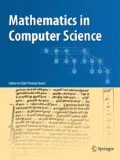Abstract
In this paper, we present a novel weighted finite automaton called palindromic subsequence automaton (PSA) that is a compact representation of all the palindromic subsequences of a string. Then we use PSA to solve the longest common palindromic subsequence problem. Our automata based algorithms are efficient both in theory and in practice.
Similar content being viewed by others
References
Breslauer, D., Galil, Z.: Finding all periods and initial palindromes of a string in parallel. Algorithmica 14(4), 355–366 (1995)
Chen, K.-Y., Hsu, P.-H., Chao, K.-M.: Identifying approximate palindromes in run-length encoded strings. ISAAC 2, 339–350 (2010)
Choi, C.Q.: DNA palindromes found in cancer. The Scientist (2005)
Chowdhury, S.R., Hasan, M.M., Iqbal, S., Rahman, M.S.: Computing a longest common palindromic subsequence. Fundam. Inform. 129(4), 329–340 (2014)
Chuang, K., Lee, R., Huang, C.: Finding all palindrome subsequences in a string. In: The 24th Workshop on Combinatorial Mathematics and Computation Theory (2007)
Farhana, E., Rahman, M.S.: Doubly-constrained LCS and hybrid-constrained LCS problems revisited. Inf. Process. Lett. 112(13), 562–565 (2012)
Galil, Z.: Real-time algorithms for string-matching and palindrome recognition. In: STOC, pp. 161–173 (1976)
Gusfield, D.: Algorithms on Strings, Trees, and Sequences—Computer Science and Computational Biology. Cambridge University Press, Cambridge (1997)
Hoshino, H., Shinohara, A., Takeda, M., Arikawa, S.: Online construction of subsequence automata for multiple texts. In: SPIRE, pp. 146–152 (2000)
Hsu, P.-H., Chen, K.-Y., Chao, K.-M.: Finding all approximate gapped palindromes. In: ISAAC, pp. 1084–1093 (2009)
http://0-www.ncbi.nlm.nih.gov.ilsprod.lib.neu.edu/nuccore/acin02000001.1. Accessed 5 Jan 2014
http://www.ncbi.nlm.nih.gov/genomes/genomesgroup.cgi. Accessed 10 July 2014
Hunt, J.W., Szymanski, T.G.: A fast algorithm for computing longest subsequences. Commun. ACM 20(5), 350–353 (1977)
Tomohiro, I., Inenaga, S., Takeda, M.: Palindrome pattern matching. In: CPM, pp. 232–245 (2011)
Iliopoulos, C.S., Rahman, M.S.: Algorithms for computing variants of the longest common subsequence problem. Theor. Comput. Sci. 395(2–3), 255–267 (2008)
Iliopoulos, C.S., Rahman, M.S.: New efficient algorithms for the LCS and constrained LCS problems. Inf. Process. Lett. 106(1), 13–18 (2008)
Iliopoulos, C.S., Rahman, M.S.: A new efficient algorithm for computing the longest common subsequence. Theory Comput. Syst. 45(2), 355–371 (2009)
Iliopoulos, C.S., Rahman, M.S., Vorácek, M., Vagner, L.: Finite automata based algorithms on subsequences and supersequences of degenerate strings. J. Discrete Algorithms 8(2), 117–130 (2010)
Kolpakov, R., Kucherov, G.: Searching for gapped palindromes. Theor. Comput. Sci. 410(51), 5365–5373 (2009)
Manacher, G.K.: A new linear-time on-line algorithm for finding the smallest initial palindrome of a string. J. ACM 22(3), 346–351 (1975)
Matsubara, W., Inenaga, S., Ishino, A., Shinohara, A., Nakamura, T., Hashimoto, K.: Efficient algorithms to compute compressed longest common substrings and compressed palindromes. Theor. Comput. Sci. 410(8–10), 900–913 (2009)
Melichar, B., Holub, J., Muzatko, P.: Language and Translation. Publishing House of CTU (1997)
Porto, A.H.L., Barbosa, V.C.: Finding approximate palindromes in strings. Pattern Recognit. 35(11), 2581–2591 (2002)
Tanaka, H., Bergstrom, D.A., Yao, M.-C., Tapscott, S.J.: Widespread and nonrandom distribution of dna palindromes in cancer cells provides a structural platform for subsequent gene amplification. Nat. Genet. 37(3), 320–327 (2005)
Tanaka, H., Tapscott, S.J., Trask, B.J., Yao, M.C.: Short inverted repeats initiate gene amplification through the formation of a large DNA palindrome in mammalian cells. Natl. Acad. Sci. 99(13), 8772–8777 (2002)
Author information
Authors and Affiliations
Corresponding author
Additional information
Part of this research work was conducted when M. Sohel Rahman was on a Sabbatical Leave from BUET and was partially supported by a Commonwealth Fellowship.
Rights and permissions
About this article
Cite this article
Hasan, M.M., Islam, A.S.M.S., Rahman, M.S. et al. Palindromic Subsequence Automata and Longest Common Palindromic Subsequence. Math.Comput.Sci. 11, 219–232 (2017). https://doi.org/10.1007/s11786-016-0288-7
Received:
Revised:
Accepted:
Published:
Issue Date:
DOI: https://doi.org/10.1007/s11786-016-0288-7




